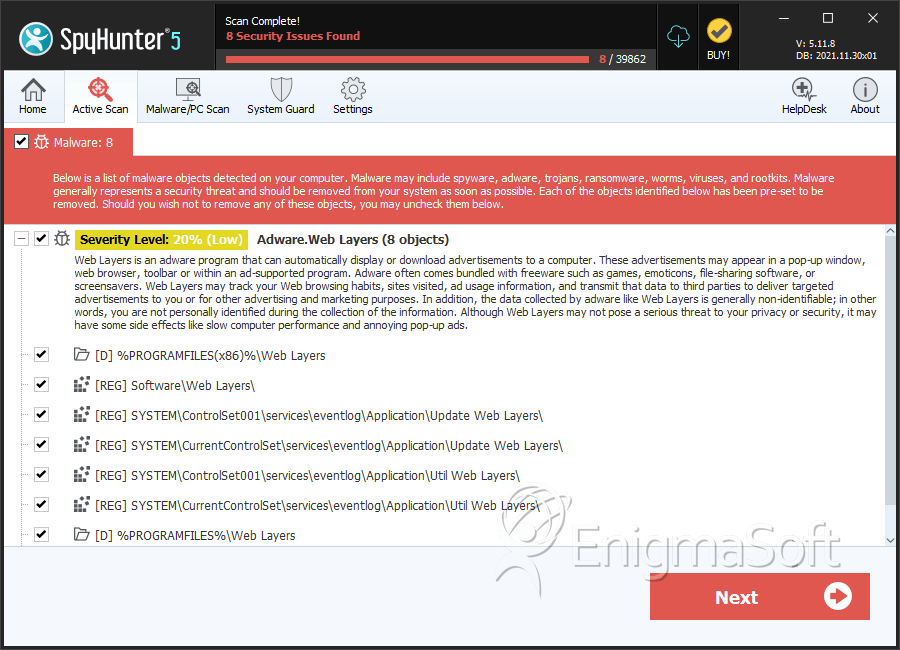Web Layers
Threat Scorecard
EnigmaSoft Threat Scorecard
EnigmaSoft Threat Scorecards are assessment reports for different malware threats which have been collected and analyzed by our research team. EnigmaSoft Threat Scorecards evaluate and rank threats using several metrics including real-world and potential risk factors, trends, frequency, prevalence, and persistence. EnigmaSoft Threat Scorecards are updated regularly based on our research data and metrics and are useful for a wide range of computer users, from end users seeking solutions to remove malware from their systems to security experts analyzing threats.
EnigmaSoft Threat Scorecards display a variety of useful information, including:
Ranking: The ranking of a particular threat in EnigmaSoft’s Threat Database.
Severity Level: The determined severity level of an object, represented numerically, based on our risk modeling process and research, as explained in our Threat Assessment Criteria.
Infected Computers: The number of confirmed and suspected cases of a particular threat detected on infected computers as reported by SpyHunter.
See also Threat Assessment Criteria.
| Threat Level: | 20 % (Normal) |
| Infected Computers: | 101 |
| First Seen: | June 5, 2015 |
| Last Seen: | October 28, 2022 |
| OS(es) Affected: | Windows |
Web Layers is a PUP (Potentially Unwanted Program). Web Layers may be associated with numerous unwanted advertisements and the presence of unwanted components on an affected Web browser. Web Layers may insert unwanted content into websites viewed on the affected computer and may b e responsible for numerous performance issues and other problems. Web Layers should be removed from an affected computer either manually or with the help of a reliable security application that is completely up-to-date.
Table of Contents
The Advertisements Displayed by Web Layers may Cause Various Issues
Web Layers is advertised as a free program that can help computer users enhance their Web browsers in a variety of ways, such as displaying special offers or related content when they view a website. However, PC security analysts have noted that content linked to Web Layers may be neither useful nor interesting. It may be basically composed of unwanted advertising material and content that may cause various problems on a computer if downloaded or installed. PC security analysts have observed that Web Layers may be responsible for numerous problems on affected computers. The following are some symptoms that may be linked to Web Layers and similar PUPs:
- Web Layers may slow down a computer significantly because Web Layers may consume system resources and bandwidth while running in the background.
- Web Layers may cause instability on affected Web browsers due to being poorly maintained and implemented. Affected Web browsers may become more prone to crashing or freezing after Web Layers has been installed.
- Web Layers may deliver large quantities of advertisements and pop-up messages to affected Web browsers, interrupting the computer users' activities and making it difficult to use the affected computer effectively.
- Web Layers may increase the risk of infection with other PUPs, adware, rogue security programs and even threats. This is because Web Layers may be linked to pop-up windows advertising these kinds of components or leading computer users to websites where these types of components may be downloaded and installed.
There are numerous types of advertisements that may be linked to Web Layers. Web Layers may use the following types of advertising material on affected Web browsers:
- Web Layers may insert links into search results on the affected Web browser.
- Web Layers may display product comparisons and reviews without being prompted to do so whenever computer users access an online shopping page.
- Web Layers may display coupons and special offers that may be fake or not significantly important to consider seriously.
- Web Layers may be associated with intrusive types of advertising such as video or sound advertisements, pop-up windows that may be difficult to close, and banner advertisements inserted into visited Web pages.
Web Layers content can be easily identified because of labels reading 'Ads by Web Layers', 'Brought to you by Web Layers', 'Powered by Web Layers', 'Web Layers Ads', etc.
How Web Layers may be Installed on a Computer
Web Layers may be installed automatically. The most common way of delivering Web Layers and similar PUPs is by bundling them with other software. No-cost programs downloaded from the Internet may join these types of PUPs or other unwanted content. During its installation, the PC user may be prompted to install Web Layers or other content. In most cases, computer users may have the option of opting out of installing Web Layers. However, this option may be made deliberately difficult to access or understand. For example, it may use convoluted language full of double negatives, come selected by default, or be hidden behind 'Custom' or 'Advanced' installation options. To prevent Web Layers from being installed, PC security analysts strongly recommend paying attention to every step of the installation process whenever installing any new software to spot unwanted content trying to sneak into your computer.
SpyHunter Detects & Remove Web Layers

Registry Details
Directories
Web Layers may create the following directory or directories:
| %PROGRAMFILES%\Web Layers |
| %PROGRAMFILES(x86)%\Web Layers |


Submit Comment
Please DO NOT use this comment system for support or billing questions. For SpyHunter technical support requests, please contact our technical support team directly by opening a customer support ticket via your SpyHunter. For billing issues, please refer to our "Billing Questions or Problems?" page. For general inquiries (complaints, legal, press, marketing, copyright), visit our "Inquiries and Feedback" page.